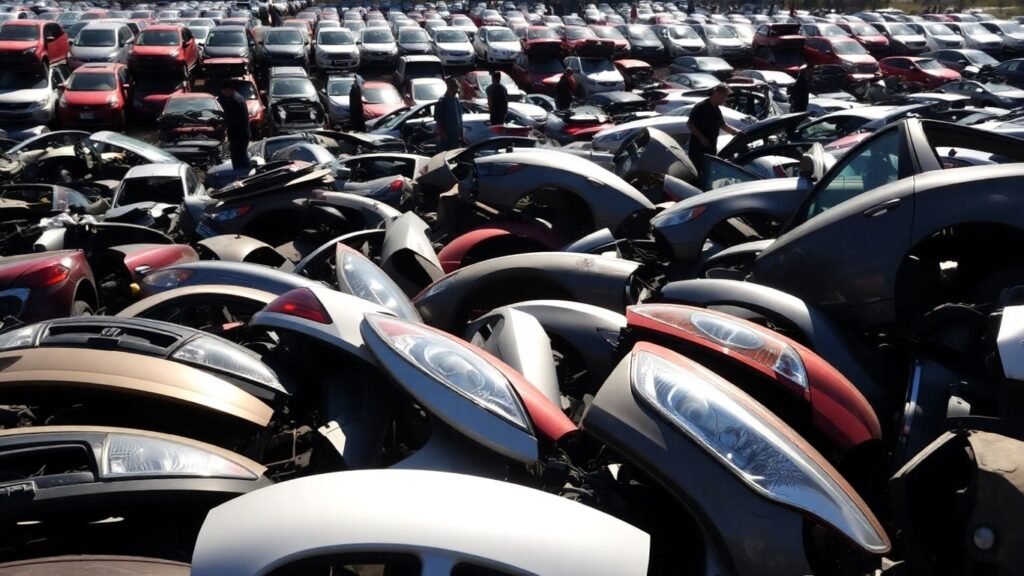Ever wonder what happens to your old Kia after it’s been in a bad accident or just can’t pass inspection anymore? Most people picture it rusting away in a junkyard, but that’s not always the case. The untold story of your Kia’s second life as spare parts is actually a lot more interesting. Salvaged Kias often get picked apart, cleaned up, and their working pieces find new homes in other cars across the country. From busy repair shops in big cities to small community garages, these parts keep other cars rolling and help people save money on repairs.
Key Takeaways
- Salvaged Kias are carefully inspected before their parts are sold, making sure only usable pieces make it to the market.
- The dismantling process is organized, with parts sorted, cataloged, and often cleaned up before resale.
- Used Kia parts travel far—some end up in major repair shops, while others help out local community projects.
- Reusing Kia parts keeps repair costs lower for car owners and supports jobs in the auto recycling industry.
- Recycling and reusing Kia parts helps cut down on waste and reduces the need for new manufacturing, which is better for the environment.
How Salvaged Kias Enter the Spare Parts Market

From Accident to Auction Block
When a Kia is totaled in a collision or deemed too costly to repair, it usually winds up in the hands of insurance adjusters. They mark the car as salvage, and then it heads for the auction block, where hundreds of damaged vehicles sit waiting for new owners. Bidders could be anyone from large salvage yards to small town mechanics looking for specific donor cars. The cars don’t linger long—salvage auctions are fast-paced, with inventory changing weekly, and certain models can even spark bidding frenzies.
Many of these Kias travel further in their second life than they ever did on the road, finding themselves shipped out to all corners of the country in search of their next fate as parts donors.
The Critical Inspection Process
Before any parts are harvested, every salvaged Kia goes through a detailed check. Mechanics pore over the engine, transmission, suspension, and body panels to spot what survived unscathed. Even if a car looks rough, there’s a good chance plenty under the hood is still in working order, ready to be stripped and tested. Safety items like airbags and seat belts are inspected with extra care, since only components that truly pass muster get considered safe for resale.
Here’s a quick comparison of pass rates for major parts from salvaged Kias in 2024 auctions:
| Part Type | Pass Rate |
|---|---|
| Engines | 70% |
| Transmissions | 65% |
| Body Panels | 60% |
| Electrical | 50% |
| Wheels/Brakes | 85% |
Why Salvaged Kias Are in High Demand
Kias have become much more popular in the last decade, so the need for replacement pieces is up too. Sometimes, it’s because original parts are pricey or backordered; in other cases, the model may be older, and factory parts just aren’t made anymore. Pulling from a salvaged Kia can mean the difference between an affordable fix and a months-long wait for rare inventory. Plus, garages know that many of these cars were in good shape before an accident—so their parts, from touchscreen displays to mirrors and injectors, still have plenty of life left.
The journey from crash to auction doesn’t spell the end for a Kia. More often, it’s just the start of a new phase pushing the whole used parts industry forward.
The Untold Story of Your Kia’s Second Life as Spare Parts: Inside the Dismantling Process
You probably don’t picture your old Kia sitting in a giant warehouse, but that’s where many end up after leaving the road. Salvage yards are busy places, filled with rows of vehicles ready to be broken down. Technicians use simple tools and heavy machinery to take apart all sorts of models—everything from a cracked Optima sedan to a totaled Sorento SUV. Taking these cars apart is way more than just yanking out an engine. Sometimes you find components that look untouched despite a rough accident. The dashboard might be wrecked, but the transmission underneath could be worth hundreds to someone who needs it.
The real surprise is how many good parts hide inside cars that, at first glance, seem to be complete wrecks. One salvaged car can sometimes help save three or four others by providing what they need.
Sorting and Cataloging Valuable Parts
After the big bits come out, everything is sorted and stored. This step matters a lot because if you don’t keep track, things go missing and it messes up the whole system. Workers label each part with the model year, fitment details, and its condition before putting it on a shelf. Some yards now use barcodes and computers, which speeds things up and helps track sales later. If you look around, you’ll see bins for taillights, shelving stacked with engines, and boxes of wiring harnesses. There’s a real rhythm to it all—it kind of reminds you of an old record shop, but instead of vinyl, it’s alternators and fenders.
| Part Type | Kept for Resale (%) | Sent for Recycling (%) |
|---|---|---|
| Engines | 60 | 40 |
| Doors | 70 | 30 |
| Electronics | 55 | 45 |
| Glass | 35 | 65 |
Environmental Considerations in Auto Dismantling
It’s not just about money—environmental rules are stricter now than they were years ago. Fluids like oil or coolant get drained out and stored so they don’t leak into the ground. Mechanics separate out plastics and metals; they can’t just be tossed in the trash. Sometimes, you’ll notice stacks of used tires set aside for special recycling. The whole process might look messy, but there’s a purpose: salvaged parts keep cars on the road longer and keep a lot of bulk out of landfills. Even something as basic as reusing a bolt saves energy in the long run.
You can never really appreciate how much waste is avoided until you see a scrap yard up close—what looks like a graveyard is really full of second chances and unfinished stories.
Where Kia Spare Parts Go: Distribution Networks and End Users
Kia spare parts don’t just sit on a dusty shelf after cars are dismantled. They move quickly, traveling through a maze of warehouses and shipping lanes before ending up in the hands of folks who really need them. This section unpacks where these components actually wind up, and how they help keep Kias and other vehicles running across the country.
Shipping to Repair Shops Nationwide
A broken bumper in Boise or a new set of headlights in Houston—repair shops rely heavily on a steady stream of recycled parts to get cars back on the road. Major distribution centers break down, organize, and box up salvaged Kia parts, then ship them out daily via trucks and couriers. Some bigger shops order directly from dismantling yards, but most parts flow through regional hubs, making sure the right pieces get where they’re needed fast. Shipping routes can cover thousands of miles. It’s a constant shuffle of boxes, barcodes, and late-night deliveries just so someone can drive to work the next morning.
| Region | Weekly Kia Parts Shipped |
|---|---|
| West Coast | 4,500 |
| Midwest | 3,200 |
| East Coast | 5,100 |
| South | 2,800 |
Online Marketplaces for Used Car Components
The internet has really shaken things up for the used parts world. Now, anyone can jump online, scroll through photos, check part compatibility, and have a replacement Kia tail light shipped to their door in days. These marketplaces aren’t just for mechanics—they’re for weekend warriors, hobbyists, and everyday car owners trying to save money. The fastest-moving Kia components online right now are mirrors, doors, and infotainment systems. There’s no waiting on the local yard to pull a part anymore; it’s all searchable with a click.
For a lot of people, finding a used Kia engine or window on a website is less of a gamble than buying new, and definitely easier on the wallet.
Supporting Community Garages and Projects
Not every Kia part heads to a big city or a chain garage. Plenty of them end up at community repair centers, nonprofit workshops, or high school auto programs. These places depend on affordable used parts to teach new skills, give second chances, or simply keep people moving. Walk into one of these shops and you’ll see rows of engines and transmissions, maybe next to a few students or volunteers turning wrenches. The impact goes beyond just fixing cars—it’s about building up neighborhoods and giving people tools, literally and figuratively, to move forward in their lives.
Shipping, selling online, or fixing up an old car for a neighbor—Kia’s spare parts are all over the place, fueling more than just engines.
Economic and Social Impact of Salvaged Kia Parts

Keeping Repairs Affordable for Car Owners
Reused Kia parts make car repairs much more affordable than buying new. For a lot of drivers, especially ones with older models, repairing cars with brand-new components just doesn’t make sense financially. Salvaged parts help stretch family budgets, and sometimes they’re the only way to keep a car running. This balance between affordability and availability keeps cars on the road longer and helps folks avoid the heavy costs of buying another vehicle.
| Repair Type | New Part Price | Salvaged Part Price | Possible Savings |
|---|---|---|---|
| Alternator | $350 | $120 | $230 |
| Headlight Assembly | $250 | $60 | $190 |
| Side Mirror | $180 | $45 | $135 |
Salvaged parts are often the difference between a finished repair and a car left sitting in the driveway.
Job Creation in Local Communities
Behind every salvaged Kia part is a small army of people—mechanics, drivers, warehouse workers, catalogers—who make it all happen. Neighborhood auto shops and dismantling yards rely on the steady flow of used components not just to get by, but to offer meaningful work to people who might not find jobs elsewhere. These are the sorts of places where folks know each other’s names, and a steady stream of work keeps the community humming. The jobs aren’t always glamorous, but they’re real, and they stick around as long as people drive old cars.
Empowering Educational and Rehabilitation Programs
Used Kia parts aren’t just for repair shops. Community garages, technical colleges, and even rehabilitation projects use salvaged components for training and second-chances. Sometimes, it’s high schoolers learning basic car skills. Other times, it’s part of a program where folks in tough spots get a shot at hands-on experience and a path to a steady job. These programs thrive when there are enough affordable, reusable parts to practice with, turning what would be scrap into hope for something better.
Old car parts teach patience, skill, and give people a chance to build a future—sometimes for the first time.
Quality Control and Safety in Reused Kia Parts
Testing and Refurbishing Standards
Every salvaged Kia part that makes it to the resale market goes through a process to figure out if it’s still good to use. Technicians will check, clean, and sometimes recondition or refurbish the parts using specialized tools. The goal is to guarantee that reused pieces—whether it’s an air conditioning compressor or a seat belt buckle—actually work before they’re sold to repair shops or online buyers. Sometimes this is just visual checks for damage, while other times it means testing the part under power to see if it performs like new. If there’s doubt, most reputable shops toss questionable parts instead of passing along something that could be unsafe.
Regulations for Salvaged Auto Components
States have rules for what can be sold from salvaged vehicles. Let’s face it, some car pieces, like airbags or brakes, are just too important to risk reusing unless they’ve been professionally restored. Sometimes, legal limits are clear: say, airbags can’t be resold unless they come from a certified rebuilder and are tested. In other cases, shops have to follow industry best practices or risk fines if regulators catch poor quality work slipping through. Regulatory agencies often do spot checks, and there’s usually paperwork tracking every batch of parts, especially for components related to safety.
| Part Type | Allowed for Resale? | Extra Testing Required? |
|---|---|---|
| Engine Blocks | Yes | Yes |
| Airbags | Sometimes* | Yes |
| Seat Belts | Yes | Yes |
| Brake Calipers | Yes | Sometimes |
*Airbags must meet local and federal testing standards.
Risks and Warranties for Buyers
Buying used Kia parts saves a lot of money, but there’s no way around it—the risk is higher than with something brand new out of the box. Warranties vary a lot, from 30 days to a full year depending on the seller and the part. Some buyers get lucky and never have a problem, while others end up needing a replacement, especially if they buy from a less reliable vendor.
It’s smart to check the warranty policy and ask about refurbishment steps before buying any used Kia part. Shops that stand behind what they sell are almost always up front about what’s covered if things go sideways.
Hidden Environmental Benefits of Giving Kias a Second Life
Reducing Landfill Waste
When a Kia reaches the end of its journey as a roadworthy vehicle, its story isn’t over. Instead of sending that car straight to the junkyard, taking it apart for parts means a lot less of it winds up in a landfill. Instead of piles of metal and plastic decaying for decades, useful bits get a whole new chance to help someone else. Each salvaged Kia keeps hundreds of pounds of material out of dumps.
| Kia Component | Avg. Landfill Avoided per Car (lbs) |
|---|---|
| Engine | 350 |
| Transmission | 225 |
| Body Panels | 100 |
| Interior Parts | 75 |
| Misc. Plastics, Glass | 60 |
Imagine several dozen cars, all picked apart for parts, contributing less waste each week. Multiply that by every salvage yard coast to coast, and soon you see how big the impact really is.
Lowering the Need for New Manufacturing
Every salvaged Kia part that gets reused means someone doesn’t have to buy that same part brand new. The process to make new parts—whether it’s an alternator or a set of wheels—uses raw materials, energy, and shipments across the world. By plugging used yet working Kia parts back into the cycle, the auto industry eases up just a little bit on its demand for fresh resources. This helps lower factory emissions, cuts down mining, and keeps more resources circulating longer.
Recycling Metals, Plastics, and Fluids
Auto dismantlers don’t just keep the big pieces—they strip Kias for everything worth saving. Once they’ve collected engines, seats, and electronics, they extract metals like steel, copper, and aluminum for proper recycling. Even oddball things like door panels get shredded, separated, and returned to industrial use. Fluids like oil and refrigerant get carefully drained and recycled instead of leaking out in a landfill or garage.
All those little efforts—from sorting wire harnesses to processing engine oil—add up to serious savings in terms of environmental impact. That’s one reason why letting your Kia live on as spare parts is a little greener than you’d expect, even if the car itself is off the road.
Wrapping It Up: The Journey of Salvaged Kias
So, that’s the story most people never hear about what happens to old Kias and other cars after they’re written off. They don’t just disappear—they get a second shot at life, piece by piece. Whether it’s a community garage in a busy neighborhood or a big auto parts warehouse, these salvaged cars keep the wheels turning for a lot of folks. Mechanics, drivers, and even young people learning the trade all benefit from the parts that get pulled and reused. It’s kind of wild to think that a bumper or a headlight from a car you once drove could end up helping someone else get back on the road. Next time you see a beat-up Kia on a tow truck, remember: it might just be starting its next chapter, helping someone else keep moving.








